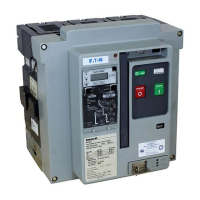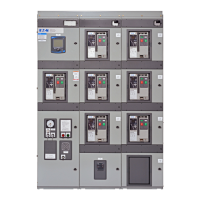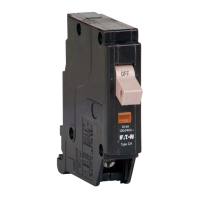46
User Manual MN013016EN
Effective July 2022
Magnum PXR and Power Defense SB low
voltage power circuit breakers user manual
EATON www.eaton.com
Maintenance schedule
Normal operating conditions
When determining how often a Magnum PXR and PD-SB breaker
should be inspected, the environmental and operating conditions
must be taken into consideration.
Table 11. Normal operating conditions
Normal operating conditions
Temperature Ambient temperature between 15 °C to 30 °C
(59 °F to 86 °F)
Percent load <80% of I
n
(sensor rating)
Relative humidity 40–70% in a noncondensing environment
Corrosive atmosphere Clean, dry, noncorrosive atmosphere
Salt environment No salt mist
Dust Protected by switchboard or switchgear assembly with
proper ventilation
Vibration Continuous vibration <0.2 g
Table 12 serves as a baseline for developing a maintenance
schedule. Under these conditions, the recommended maintenance
frequencies should be followed as written below.
Table 12. Normal maintenance frequency
Test/inspection Frequency
Arc chute inspection 1 year
Primary contact inspection 1 year or after a short circuit interruption
Internal mechanism inspection Every 250 operations or 3 years
Primary disconnect inspection
(drawout applications only)
Every time breaker is racked out
Secondary connection inspection Every time breaker is racked out
Interlocks inspection Every 250 operations or 3 years
Trip unit testing (primary injection) 5 years
Trip unit testing (secondary injection) 2–3 years
Adjusting maintenance frequency
Although Magnum PXR and PD-SB breakers are designed and
manufactured to operate in a wide variety of applications and
environments, there are some conditions that may require inspection
frequency to be increased.
Table 13. Increased frequency conditions
Factor Condition limits Recommended action
Operating conditions
High cycling Greater than one operation every 2 minutes Inspect every 1500 operations
Low cycling Less than one operation per year Double the normal inspection frequency
Repeated interruptions or overloads Three interruptions or 50 overloads (28 overloads for >2000 A breakers) Double the normal inspection frequency
Capacitive switching >135% of the capacitive bank load Double the normal inspection frequency
Environmental conditions
Temperature Ambient temperature is above or below 15 °C to 30 °C (59° F to 86° F) Double the normal inspection frequency
Temperature Breaker is placed in an area with a strong solar influence Double the normal inspection frequency
Dirt and contaminants Visible dirt or contaminants Remove contaminants from the breaker
and double the normal inspection frequency
Corrosive atmospheres Breaker is used in water or wastewater, pulp
and paper, petrochemical, or other harsh industrial atmospheres
Double the normal inspection frequency
Altitude >2000 m (6562 ft) Use appropriate voltage and current correction factors.
See Table 14 for rating factors. Short circuit current is not affect-
ed as long as the voltage is rated in accordance with the table.
Humidity Breaker is placed in a condensing environment Double the normal inspection frequency and inspect for rust
Use this table for ratings factor.
Table 14. Altitude rating factors
Altitude (meters) Voltage correction Current correction
2000 1.000 1.000
2100 0.989 0.998
2300 0.976 0.995
2450 0.963 0.993
2600 0.950 0.990
2750 0.933 0.987
2900 0.917 0.983
3050 0.900 0.980
3200 0.883 0.977
3350 0.867 0.973
3500 0.850 0.970
3650 0.833 0.967
3800 0.817 0.963
3950 0.800 0.960
5000 0.700 0.940

